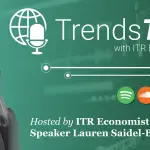WEEKLY FED WATCH
This week on Fed Watch, ITR Economist Taylor St. Germain examines the latest happenings at July’s FOMC meeting, puts a spotlight on US Nondefense Capital Goods New Orders data, and considers the potential for the Federal Reserve to cut interest rates in September.
The below transcript is a literal translation of the podcast audio that has been machine generated by Notta.
Hi, everyone. My name is Taylor St. Germain with ITR Economics, and welcome to the August 2nd edition of Fed Watch. Two things I wanted to talk about on this episode. First, we had an FOMC meeting on July 31st, just this week.
So I wanted to summarize what we’re hearing from Chairman Powell and the FOMC. Then I wanted to discuss the new orders data that came out today. And it’s an extension of Brian’s theme last week, which is that we are continuing to see from our perspective this data moving along the backside of the business cycle and weakening.
But first, let’s start with this FOMC meeting. So on July 31st, the FOMC decided to keep the Fed funds rate unchanged. So we’re still at that range of 5.25 to 5.5 percent. This is the eighth consecutive meeting that they’ve left the Fed funds rate unchanged.
Now, the committee, along with Chairman Powell, cited that the recent indicators showed solid economic activity, moderate job gains, job gains in a slight increase in the unemployment rate, though it remains relatively low.
Inflation has continued to ease, especially in terms of the benchmarks the Fed is looking at, but is still somewhat elevated compared to that 2 percent target. So after the summary that Chairman Powell provided, he emphasized that they do not expect to reduce the Fed funds rate until they are confident that this inflation is sustainably moving towards that 2 percent goal.
Now, my takeaway from watching the meeting is they’re confident that we are moving in that direction, but you know they’re going to be very careful with their messaging as they’re going to continue to evaluate each month of data.
So they highlighted we’re going to continue to watch the incoming data, especially the labor market conditions and inflation pressures to balance the risks of this dual mandate in terms of price stability and full employment.
Now, after the meeting, as we look ahead, analysts are anticipating that if this economic data still slows, especially on the inflation front, that we might get that 25 basis point cut at the September 18th, 2024 meeting.
Now, when Chairman Powell was asked more directly about that, he said. Anywhere from no cuts to multiple cuts are still on the table in his perspective. But again, from our perspective here at ITR, this data is still weakening.
And another good inflation report in terms of slowing would tell us at least that it’s likely that these interest rates will be coming down late here in 2024. Now, I want to cover a data point on our end, especially because of the impact that it has related to interest rates and inflation.
I’m talking about the new orders data set, which is U .S. non -defense capital goods, new orders. And again, last week, Brian highlighted starting to see slowing in the housing market. Retail sales is on the backside of the business cycle.
And when we look at the non -defense capital goods new orders data set, which is our proxy for business to business spending, we actually saw that 112. So that’s the current month compared to the same month last year dropped to a minus 2 .1 percent.
That is the lowest level in three and a half years. And we are in that negative territory. So it’s clear that businesses are also pulling back on their level of spending. And if we look at the first to second quarter percent change for this new orders CapEx trend, we saw a below average first to second quarter percent change.
So the data continues to weaken. And for me, that would suggest that, again, as long as we get another good inflation report, we will likely see these interest rates coming down late this year. So all in all, the Fed seems at least the tone from the meeting seems more clear to me that we’re getting closer and closer to these rate cuts.
And I think that’ll be important for an economy that’s slowing down, especially in terms of business to business spending, starting to show contraction year over year. September will be an important month and we’ll have a lot of conversations around that September 18th meeting that’s coming our way.
Thanks for joining me on this edition of Fed Watch. Please remember to like and subscribe to ITR’s podcast, wherever you listen to your podcasts. And I look forward to seeing you on the next one.


